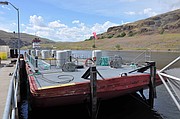Fish kill the new story in dam breach saga
BURBANK — Ice Harbor Dam and three others on the lower Snake River have long been the targets of environmentalists who’d like to do away with all dams in favor of fish.
Dams are essential to irrigators who make their living cultivating lands by diverted river water. If a federal judge ever agrees with the environmentalists, that decision will likely to have a devastating economic impact on the regions agricultural industry.
This story started with the Endangered Species Act (ESA) of 1973. It called for all federal agencies that might be endangering a species to develop a Biological Opinion (BiOp), which laid out the corrective steps.
The U.S. Army Corps of Engineers (USACE), which operates Ice Harbor, Lower Monumental, Little Goose and Lower Granite Dams, was one of those agencies. With the help of the National Oceanographic and Atmospheric Administration, the Bonneville Power Administration and the U.S. Bureau of Reclamation, the Corps developed the BiOp by which it operates.
According to consultant Darryll Olsen, Ph.D., board representative of the Columbia Snake River Irrigators Association (CSRIA), the BiOp has worked as planned. The Snake River fish populations are larger now than they were before the ESA BiOp measures were implemented, he said.
The environmentalists don’t agree that’s enough, so they asked U.S. District Court Judge Michael Simon of Oregon in January for an injunction to force increased water spill over the dams.
Simon is the latest judge overseeing a lawsuit filed 25 years ago by the State of Oregon and environmental groups against the Corps and the State of Washington. These groups have asked for breaching of the dams.
Simon held a hearing on March 9 on the motion for injunction. He effectively tossed the spill decision forward to after 2018, when a new BiOp will be in place.
As far as Olsen is concerned, the injunction request was an attempt to predetermine the measures that would be included in the new BiOp. He said that the plaintiffs are using the issue to extract more fish and wildlife funding from the BPA, which is now at about $800 million per year, and they still want to breach the dams.
Olsen said Simon made statements early in the hearing that placed him on the side of the environmentalists. But Simon bounced his decision forward. Even so, Olsen believes the spill operations put into question whether the plaintiffs are as committed to saving and growing the fish populations as the defendants.
Olsen and others claimed that the some of the fish agencies’ managers caused a massive fish kill in 2015. The full effects of it will be known when the adult fish returns of 2017-18.
Olsen said the plaintiffs did not respond to the allegation, and he doesn’t expect them to.
Smolts (or juveniles) generally come down the Snake in April and May on their migration to the ocean. In accordance with the BiOp, the Corps has been allowing half of the smolts to go over the dams. Special barges to the Columbia River below Bonneville Dam are being used transport the other half.
The transport program was given a trial run in 1977, and then instituted fully in 1978. That and several other mitigation measures by the Corps have dramatically grown the fish populations.
From 1993 to 2006, upward of 60 to 98 percent of juveniles were transported, according to the Columbia River Research Corp. Then as other measures were having a positive effect, those responsible for fish passage decisions dropped transport to about half of the smolts.
Then 2015 happened. Fish passage managers transported about 13 percent because of faulty decisions, Olsen and fish specialists said. Although NOAA scientists warned that flow and temperature conditions in the river required that the transport program start in early or mid-April, the fish passage managers, who Olsen believes support the breaching view, would not agree and started transporting on May 1.
Olsen and former Corps Juvenile Transportation Project Manager John McKern testified to these facts. Both said the 2015 in-river flow-temperature conditions were lethal.
NOAA Fisheries’ key scientists called for immediate fish transport operations twice, but their requests were rebuffed by onsite fish passage managers, Olsen and McKern told the court.
“CSRIA legal counsel described the legal and operational management that should have guided fisheries operations in 2015, but they were either overlooked or deliberately altered,” Olsen said
The transportation barges are made especially for the care of fish as they are moved down the river. Fish enter the barge with a water temperature equal to that behind Little Goose and Little Granite, where they are loaded daily during the transport season.
As the fish move down the river, the water temperature in the barge is adjusted gradually so that when the fish re-enter the river below Bonneville, they do so at the local temperature.
Since 1973, Northwest electrical power users have paid the millions of dollars of litigation and mitigation costs. They are paid through power rates, and a good share of the population, I suspect, is probably not aware of that.
With renewed energy, Olsen said the CSRIA wrote to the USACE/Department of Justice to invoke the Endangered Species Act Committee to try to get to a conclusion in the 25-year court case.
“This is just crazy. We’ve got to get out of this,” Olsen said.
There are meetings planned for early April in Washington, D.C. with senior staff at the Department of the Interior.
“I was pleased they called and said they were ready to set up the meetings,” Olsen said.
This story is just beginning.







